|
|
|
 |

 |
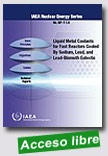 |
Liquid Metal Coolants for Fast Reactors (Reactors Cooled by Sodium, Lead and Lead-bismuth Eutectic)
IAEA Nuclear Energy Series, 2012, 82 p.
This publication is intended to provide a comprehensive summary of the status of the liquid metal coolant technology development for fast reactors, with regard to basic data and main technological challenges. It also covers various fast reactor concepts and designs that are being investigated, with special emphasis on the choice of the coolant.
The choice of the coolant is one of the main technical issues concerning fast reactors design, since it determines design
|
approach as well as technical and economic characteristics of the system. Moreover, several aspects concerning coolants are related to the reliability and safe operation of liquid metal cooled fast reactors (LMFRs). These aspects are in the field of coolant quality control, materials compatibility, thermal-hydraulics behaviour in different operation regimes, and innovative and robust instrumentation and measurement techniques development. It is worth noticing that several R&D areas might be common to both types of LMFRs — i.e. sodium and HLM cooled FR — as, for example, the development of ODS steels for the fuel cladding to increase the burnup, or the development of MA bearing fuels. Significant experience in liquid metals technology has been gathering thanks to a number of R&D activities, as well as the design, construction and operation of several experimental and prototype fast reactors; this know-how represents a key factor for future developments, in particular as far as the so called Generation IV nuclear systems. The need to preserve knowledge and to exchange information is a major recommendation by the IAEA Technical Working Group on Fast Reactors (TWG-FR); therefore this report represents the joint effort of various Member States with an active fast reactor programme to collect, review and document the available information about liquid metal coolants — sodium, lead and lead-bismuth — for fast neutron systems.
Extraído de:
http://www-pub.iaea.org/MTCD/Publications/PDF/P1567_web.pdf
|
 |
 |
The Role of Nuclear Energy in a Low-carbon Energy Future
Nuclear Energy Agency (NEA), 18/06/12, 92 p.
This report assesses the role that nuclear energy can play in supporting the transition to a low-carbon energy system. It begins by considering the greenhouse gas emissions from the full nuclear fuel cycle, reviewing recent studies on indirect emissions and assessing the impact that nuclear power could make in reducing greenhouse gas emissions.
The report provides estimates of the construction rates that would be needed to meet the projected expansion of nuclear
|
power foreseen by many energy scenarios published by international organisations. It then assesses the economic, technical, societal and institutional challenges represented by such an expansion to identify the most significant barriers. The capacity of nuclear power plants to operate in an electricity system with a large share of renewables, and the impact of smart grid technologies are also examined. Finally, long-term prospects for nuclear energy are discussed in terms of development of new reactor and fuel cycle technologies, non-electric applications and new operational and regulatory constraints that could arise as a consequence of climate change.
Extraído de: http://www.oecd-nea.org/
|
 |
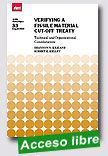 |
Verifying a Fissile Material Cut-off Treaty: Technical and Organizational Considerations
Stockholm International Peace Research Institute, August 2012, 52 p.
The renewed momentum behind international efforts to negotiate a fissile material cut-off treaty (FMCT) has focused attention on how the proposed ban on the production of fissile material will be verified: what type of organization should be given this responsibility and what technical expertise will it require?
|
The International Atomic Energy Agency (IAEA) is often identified as the obvious choice for this role, given its long experience in implementing nuclear safeguards agreements. Many of the tools and procedures developed by the IAEA for safeguards purposes could be directly applied to verifying a future FMCT. However, without changes to its existing safeguards mandate and practices, the IAEA would be hindered in verifying treaty compliance in the nuclear weapon-possessing states. This Policy Paper proposes an alternative arrangement that, while taking advantage of the IAEA's experience and expertise, creates a verification body tailored specifically for an FMCT with the requisite legal mandate and technical capabilities.
Extraído de: http://books.sipri.org/product_info?c_product_id=448
|
 |
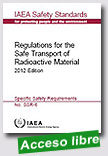 |
This publication establishes the regulations that apply to the transport of radioactive material by all modes of transport on land, water or in the air, including transport that is incidental to the use of the radioactive material. The objective and scope of the regulations are described in detail as well as the range of their application. The publication provides requirements useful to governments, regulators, operators of nuclear facilities, carriers, users of radiation sources and cargo handling
|
personnel. Contents: 1. Introduction; 2. Definitions; 3. General provisions; 4. Activity limits and classification; 5. Requirements and controls for transport; 6. Requirements for radioactive materials and for packagings and packages; 7. Test procedures; 8. Approval and administrative requirements; Annex I: Summary of approval and prior notification requirements; Annex II: Conversion factors and prefixes; Annex III: Summary of consignments requiring exclusive use. (Formerly known as TS-R-1).
Extraído de:
http://www-pub.iaea.org/books/IAEABooks/8851/Regulations-for-the-Safe-Transport-of-Radioactive-Material-2012-IAEA-Safety-Standards-Series-Requirements
|
 |
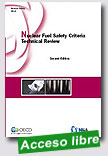 |
Nuclear Fuel Safety Criteria Technical Review -Second Edition
Nuclear Energy Agency (NEA), 2012, 83 p.
Most of the current nuclear fuel safety criteria were established during the 1960s and early 1970s. Although these criteria were validated against experiments with fuel designs available at that time, a number of tests were based on unirradiated fuels. Additional verification was performed as these designs evolved, but mostly with the aim of showing that the new designs adequately complied with existing criteria, and not to establish new limits. In 1996, the OECD Nuclear Energy Agency (NEA)
|
reviewed existing fuel safety criteria, focusing on new fuel and core designs, new cladding materials and industry manufacturing processes. The results were published in the Nuclear Fuel Safety Criteria Technical Review of 2001. The NEA has since re-examined the criteria. A brief description of each criterion and its rationale are presented in this second edition, which will be of interest to both regulators and industry (fuel vendors, utilities).
Extraído de: http://www.oecd-nea.org/ |
 |
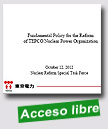 |
Fundamental Policy for the Reform of TEPCO Nuclear Power Organization
TEPCO Nuclear Reform Special Task Force, October 12, 2012, 32 p.
Plan to compile a Reform Plan in relation to the following four items. Furthermore, effective and ineffective lesson learned from past TEPCO reforms and changes will be identified and incorporated in the Reform Plan.
|
Reform from top management - Take the initiative to fully exercise leadership to improve safety. In order to do so, clarify requirements and reinforce staffing to support management; Assume the unexpected and develop capabilities during normal times to respond to contingencies.
Reform to become a self-led organization - Restructure emergency organization (implementation of ICS); Review HR development program; Reform to become an organization that can layer defense-in-depth (rejecting assumptions) Reform work processes - Shift from perfect countermeasures to quickly implemented measures; Develop mechanisms conducive to layering defense-in-depth (rejecting assumptions); - Review HR development program Reform relationships with the regulator, siting community, and the public - Enhance risk communication (improve transparency) This Reform Plan is not goals; but checks for progress and review as part of unceasing effort to improve safety.
Extraído de:
http://www.tepco.co.jp/en/press/corp-com/release/betu12_e/images/121012e0101.pdf
|
 |
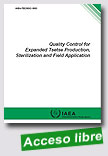
|
Improved and Harmonized Quality Control for Expanded Tsetse Production, Sterilization and Field Application
IAEA TECDOC, 2012, 149 p.
The use of the sterile insect technique for the control or eradication of tsetse flies is progressing towards the first large scale programmes on mainland Africa. To enable these programmes, the rearing of tsetse flies has to be much expanded and with the expansion, issues of quality control become more important. This publication provides an analysis of several aspects of quality in tsetse fly production and expands or enhances many of the current quality control procedures.
|
Extraído de:
http://www-pub.iaea.org/books/IAEABooks/8725/Improved-and-Harmonized-Quality-Control-for-Expanded-Tsetse-Production-Sterilization-and-Field-Application
|
 |
 |
Spent Nuclear Fuel: Accumulating Quantities at Commercial Reactors Present Storage and Other Challenges
The Government Accountability Office (GAO-US), August 2012, 66 p.
The amount of spent fuel stored on-site at commercial nuclear reactors will continue to accumulate—increasing by about 2,000 metric tons per year and likely more than doubling to about 140,000 metric tons—before it can be moved off-site, because storage or disposal facilities may take decades to develop. In examining centralized storage or permanent disposal options,
|
GAO found that new facilities may take from 15 to 40 years before they are ready to begin accepting spent fuel. Once an off-site facility is available, it will take several more decades to ship spent fuel to that facility. This situation will be challenging because by about 2040 most currently operating reactors will have ceased operations, and options for managing spent fuel, if needed to meet transportation, storage, or disposal requirements, may be limited.
Studies show that the key risk posed by spent nuclear fuel involves a release of radiation that could harm human health or the environment. The highest consequence event posing such a risk would be a self-sustaining fire in a drained or partially drained spent fuel pool, resulting in a severe widespread release of radiation. The Nuclear Regulatory Commission (NRC), which regulates the nation’s spent nuclear fuel, considers the probability of such an event to be low. According to studies GAO reviewed, the probability of such a fire is difficult to quantify because of the variables affecting whether a fire starts and spreads. Studies show that this low-probability scenario could have high consequences, however, depending on the severity of the radiation release. These consequences include widespread contamination, a significant increase in the probability of fatal cancer in the affected population, and the possibility of early fatalities. According to studies and NRC officials, mitigating procedures, such as replacement water to respond to a loss of pool water from an accident or attack, could help prevent a fire. Because a decision on a permanent means of disposing of spent fuel may not be made for years, NRC officials and others may need to make interim decisions, which could be informed by past studies on stored spent fuel. In response to GAO requests, however, NRC could not easily identify, locate, or access studies it had conducted or commissioned because it does not have an agencywide mechanism to ensure that it can identify and locate such classified studies. As a result, GAO had to take a number of steps to identify pertinent studies, including interviewing numerous officials.
Transferring spent fuel from wet to dry storage offers several key benefits, including safely storing spent fuel for decades after nuclear reactors retire—until a permanent solution can be found—and reducing the potential consequences of a pool fire. Regarding challenges, transferring spent fuel from wet to dry storage is generally safe, but there are risks to moving it, and accelerating the transfer of spent fuel could increase those risks. In addition, operating activities, such as refueling, inspections, and maintenance, may limit the time frames available for transferring spent fuel from wet to dry storage. Once spent fuel is in dry storage, there are additional challenges, such as costs for repackaging should it be needed. Some industry representatives told GAO that they question whether the cost of overcoming the challenges of accelerating the transfer from wet to dry storage is worth the benefit, particularly considering the low probability of a catastrophic release of radiation. NRC stated that spent fuel is safe in both wet and dry storage and that accelerating transfer is not necessary given the small increase in safety that could be achieved.
Extraído de: http://www.gao.gov/products/GAO-12-797
|
 |
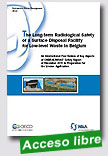 |
The Long-term Radiological Safety of a Surface Disposal Facility for Low-level Waste in Belgium
Nuclear Energy Agency (NEA), 08/10/12, 100 p.
An important activity of the OECD Nuclear Energy Agency (NEA) in the field of radioactive waste management is the organisation of independent, international peer reviews of national studies and projects. This report provides an international peer review of the long-term safety strategy and assessment being developed by the Belgian Agency for Radioactive Waste and Enriched Fissile Materials, ONDRAF/NIRAS, as part of the licence
|
application for the construction and operation of a surface disposal facility for short-lived, low- and intermediate-level radioactive waste in the municipality of Dessel, Belgium. The review was carried out by an International Review Team comprised of seven international specialists, all of whom were free of conflict of interest and chosen to bring complementary expertise to the review. To be accessible to both specialist and non-specialist readers, the review findings are provided at several levels of detail.
Extraído de: http://www.oecd-nea.org/
|
 |
|
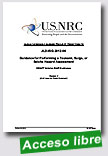
|
Guidance for Performing a Tsunami, Surge, or Seiche Hazard Assessment - Draft Interim Staff Guidance
Nuclear Regulatory Commission (US), 2012, 46 p.
This interim staff guidance is being issued to describe to stakeholders methods acceptable to the staff of the U.S. Nuclear Regulatory Commission (NRC) for performing tsunami, surge, or seiche hazard assessments in response to NRC’s March 12, 2012 request for information (Ref. (1)) issued pursuant to “Title 10, Code of Federal Regulations, Part 50, Section 54 (10 CFR 50.54)” regarding Recommendation 2.1 of the enclosure to
|
SECY-11-0093, “Recommendations for Enhancing Reactor Safety in the 21st Century, the Near-Term Task Force Review of Insights from the Fukushima Dai-ichi Accident” (Ref. (2)).
This ISG will assist operating power reactor respondents and holders of construction permits under 10 CFR Part 50 with performance of hazard assessments for tsunami, surge, or seiche. It should be noted that the guidance provided in this ISG is not intended to describe methods for use in regulatory activities beyond the scope of the March 12, 2012, 50.54(f) letter.
Extraído de: http://pbadupws.nrc.gov/docs/ML1227/ML12271A036.pdf
|
|
|
|
|
|
|
